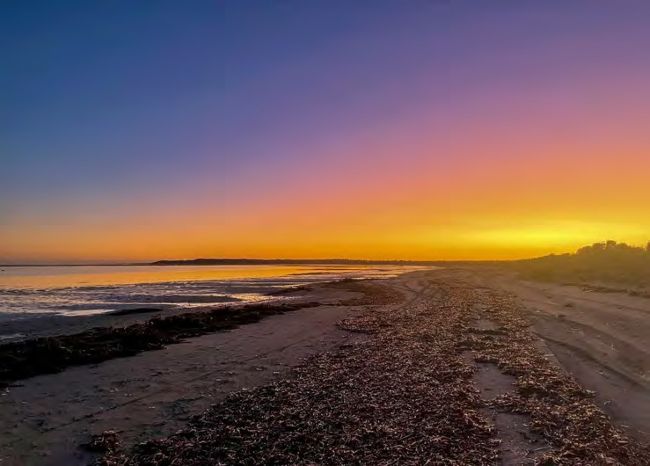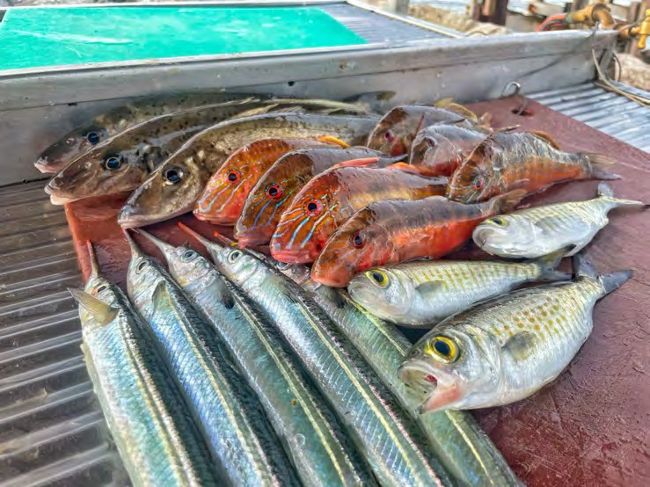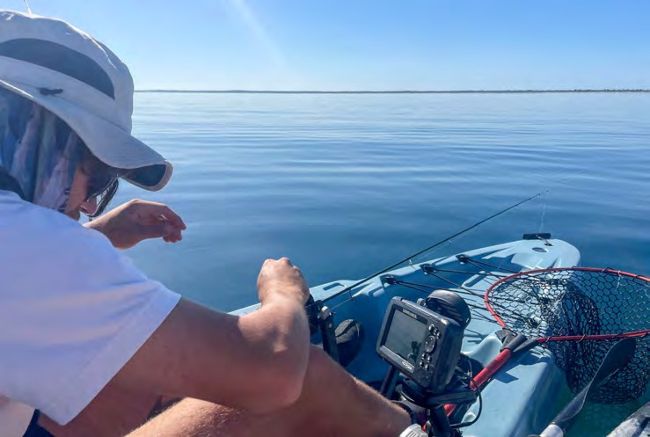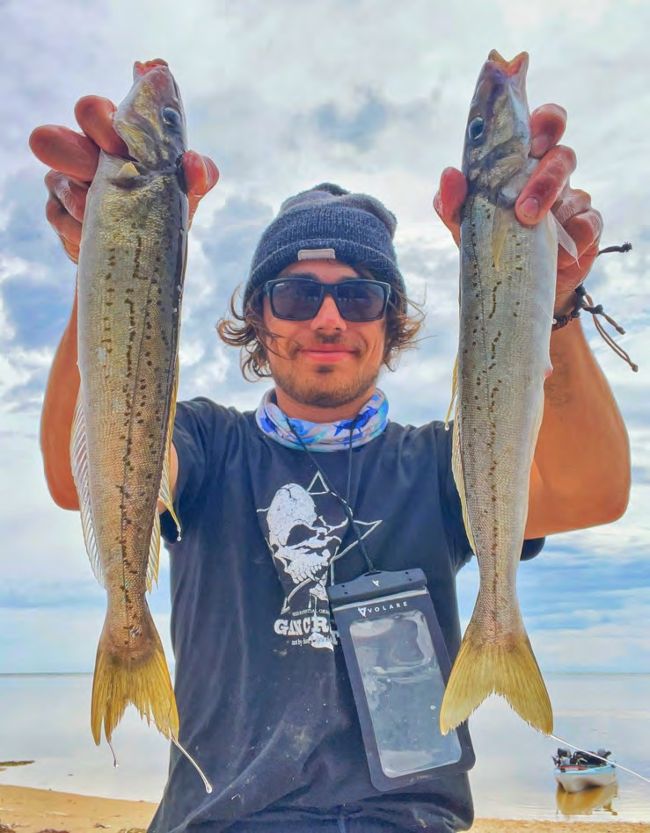GOING ULTRA-LIGHT ON KING GEORGE
Oliver Wood reckons adopting finesse fishing methods to target whiting injects a heap more fun into the whole exercise.
King George whiting is one of the most sought-after species by boat and land-based anglers alike. But what if I told you that I could make chasing them one of the most exhilarating and rewarding forms of fishing as well? Before I get started, I’d like to acknowledge that this form of fishing is more suitable for the boat-based/kayak-based anglers out there, but it is certainly possible to target King George with ultra-light gear from the convenience of the land.
King George whiting are found in many of the inshore coastal environments here in SA, and are particularly fond of intermittent seagrass beds, sand holes and reef that are commonly located between 1-20m of water. They can be found foraging for small morsels in and amongst sand holes, burrowing their mouths beneath the sand in search for worms and small crustaceans. As well as feeding in these sand holes, they can be found hiding and sitting in the seagrass beds, which is why fishing the sand holes is a must, as you are targeting the feeding fish, not the spooked, docile fish.
I have found the most success targeting them from May through to December, peaking between the months of July to September. It is during these months that King George congregate in large schools, feeding heavily in order to gain condition for the approaching breeding season.

Being on the water early often helps
The ultra-light style of fishing involves light weight and light action rods, built for sensitivity and finesse. It also involves good quality, lightweight reels spooled with the best, most sensitive, thin and tough braid. All this ultra-light gear will allow you to gain the most out of tackling these strong fighting fish, as well as detecting the often-subtle bites. Connecting with a big King George on ultralight gear is a feeling like no other, and I am absolutely hooked on it.
Why choose ultra-light over the conventional 3000 size or even 2500 spin size whiting setups that you are used to seeing? Not only is this style of fishing more enjoyable, but I believe it to be more effective, especially when the whiting aren’t playing the game. The traditional, heavier outfits can be cumbersome and heavy. When fishing with rod in hand, I always enjoy a lighter, more comfortable set up. My personal set-up for these fish tips the scales at around 230g with braid, making it extremely comfortable in hand, even in longer sessions.
Like most of the fishing tackle these days, the Japanese market creates the best ultra-light gear, with countless companies making their version of the best finesse rods. In Japan the finesse style is named Ajing, after the smallish species of fish that these rods are designed to target called ‘Aji’ or, as we know it here in Australia, the yellowtail scad or ‘yacka’ for short. These rods are also perfect for targeting our King George whiting, as well as other smaller target species here in SA.
My personal rod specification recommendation is a length between five feet ten to six feet five, and a line rating anywhere between PE 0.06 to PE 0.6. Anything lighter, you put yourself at a great risk of snapping your rod, and any heavier you tend to miss out on the added sensitivity benefits. Do not be intimidated by the price of some of these rods. There are many different rods in the market to suit any angler’s budget, with plenty of quality examples ranging between $100-200.
A personal favourite starter rod is the Abu Garcia Veritas VRT3.5 662UL. This is an extremely userfriendly rod that is not prone to breaking under strain. Compared to a high-end finesse rod, it does lack some sensitivity, but is very reasonably priced for the beginner finesse angler. If you are looking to spend a little more, I have found the Tenryu Lunakia range and the Yamaga Blanks Blue Current range to be the best two finesse rod ranges on the market today.

It's not all KG's - the by-catch often helps top up the bag
There are many different reels that suit this form of fishing. I recommend a light, 1000 or 2000 size reel of your choosing, I believe the lighter, the better. Pair that reel with some quality, light yet strong braid and you will have a dynamite rod and reel combination. I have found my 1000 size Shimano Stradic CI4+ to be the perfect little package, combining strength, toughness, finesse and a buttery smooth drag. This reel has landed countless King George, as well as my personal best snapper during one of my Whiting missions.
Interestingly, I have found the size 2000 Daiwa reels to be preferable, as they offer a touch more grunt on the larger fish. I have thoroughly enjoyed my little 2000 Caldia on these fish utilising this method. Finesse reels have a wider range of prices than finesse rods, with the best cheap reel being the Shimano Sienna 1000. Moving slightly up from that, the best mid-range reels I have found to be the Shimano Sedona and Stradic, and the Daiwa Freams, Caldia. These reels offer the best ‘bang for buck,’ with a refined design, tough gearing and a much lighter profile. For the anglers who enjoy luxury, the Daiwa Exist and Shimano Stella top off the finesse market at a whopping price of around one thousand dollars. When selecting your ideal reel, I always recommend heading to your local tackle store with your rod and trying the reels on. Look for a light, balanced and smooth performing reel.
Selecting the correct braid is the most important decision you will make after purchasing a rod and reel. I cannot understate the importance of a good quality braid to spool up to your reel of choice. When I think braid, I immediately think Gosen. Gosen is a Japanese-born and bred braid maker that has been around since the 1950s and, in my opinion, makes the best braid on the market. Recently Gosen has released a specialty ‘Roots’ braid that I think finds the perfect mixture between thin, light, sensitive and tough. It’s perfect for this form of fishing. I have this braid in PE 0.4 spooled up on my Stradic and have been loving every fight. It has never failed on me, and I could not recommend it more to any finesse angler.
Some may question the versatility of a set-up like this. However, I have successfully used my set-up in depths from 1-20m of water, fishing heavy current and in a variety of conditions. I am very pleased to say that it is just as versatile as the traditional, heavier rods.
I have found the simple, yet effective double paternoster to be the best rig to use in general when you are whiting fishing. A universal rule of the paternoster is to make sure the bottom hook sits a good 5cm or so above the sinker to avoid snagging and tangles. When making rigs, I use 12-14 pound fluorocarbon. I have found this to be ideal, as it isn’t too thick that the fish will see it, but provides a userfriendly application, rarely tangling.

A basic sounder is all you need
The style and slightly varied technique that is required for this form of fishing leans towards circle hooks being slightly more effective. However, ‘J’ and bait holder hooks can also work. Black Magic makes a fantastic circle hook as well, with Mustad being my preferred hook brand of choice due to their toughness and continued sharpness, fish after fish. These have been the only hooks I will use for more than one session, proving how sharp and effective they are.
Along with your preferred whiting hook and rig comes a sinker. To keep the discussion of lead as short and as simple as it gets, use a weight that is just enough to get you to the bottom. A snap swivel or dropper loop at the end of your rig will make life easier if you need to change sinker size based on the conditions. I also tie a small, 30cm leader to my braid of choice to ensure that my line remains invisible to these fish, as well as offering a bit more abrasion resistance and greater knot strength to my snap swivel.
The technique doesn’t differ all that much from the norm, however there are some key tips and tricks that will ensure you connect with some quality fish. To briefly revisit the dull, yet important topic of sinkers, I have advised using the lightest sinker possible to get you down to the bottom. I have found all whiting species, especially King George, hate the feeling of tension in fishing line, often nibbling at the bait or spitting it out altogether. So, having a smaller sinker will allow for the fish to take the bait without the feeling of weight on their mouth. This will give you better hook-ups and thus, more fish. To add to this, ultra-light fishing allows the angler to use a slight bit of slack in the line and still feel every enquiry.
When using circle hooks, you will often receive advice not to strike as the fish hooks themselves. This is correct when utilising punchier, heavier rods where striking will simply pull the hook out of their mouths. This is where ultra-light really comes into its own. The soft nature of these light rods will enable you feel the exact moment the fish has the bait in its mouth —due to the slight bend and added tension on your line. At this moment strike firmly, placing the circle hook into the corner of the mouth for the perfect hook set, every time. Be careful not to strike too hard, as this could put added stress on your rod, causing it to snap!
My most recent session targeting South Aussie royalty took me to a familiar location of mine near the very popular Port Hughes, on Yorke Peninsula. I had it on good authority that there were fish biting around this area in previous weeks, so I made sure to keep an eager eye on the weather, looking for a fishable window. After a week of constant 20 knot onshore winds, a threeday window appeared. I always enjoy targeting King George after a big blow, as I find the choppier, murkier conditions to promote their feeding. I promptly packed all my camping, kayaking and fishing gear, ready for a mission to the whiting grounds. With anticipation for the trip at an all-time high, I started the twohour car journey to the spot well before dawn. I always love the excitement of another fishing trip building up along a car journey.
After setting up camp, kayak and fishing gear, I was ready for the walk and paddle out to my favourite whiting hole I have happily named ‘Holey Moley’ — due to some of my previous fishing sessions at this spot that have left me saying such. After a long slog through some kneedeep mud, I was finally able to paddle out the short 300m or so to the whiting grounds. Using some preserved blood worms as bait, sitting perfectly on my circle hook, I cast into my favourite sand hole and before I could say ‘King George,’ I was onto a beautiful fish, burying its nose in the current, taking short hard bursts, and peeling line off my 1000 Stradic. The absolute excitement from a fight like this put an earto-ear smile on my face — a fight and feeling that I will never tire of. Fortunately, this whiting was not alone, with fish after fish coming onto the kayak. This exciting session was brief, as I landed my bag limit in just under 40 minutes and left them biting.

The author with two light tackle thumpers
The next two days were more of the same —bent rods, screaming Stradics and full eskies. In these sessions anyone could have landed their limit on any fishing gear, but I guarantee I had the most fun while doing it. Personally, these sessions were my best ever, bagging my limit every day in under 45 minutes, rounding off the perfect fishing mission targeting this truly iconic, South Aussie species.
This method of fishing suits beginner anglers and even the seasoned whiting veterans, posing a new, exciting way of landing a feed of these incredible fish. There is nothing quite like connecting with a big model on light gear and, if you decide to give this ultra-light fishing a shot, I guarantee you will be hooked like I am. If you have any questions about this form of fishing, I will be more than happy to help. Just message me on Instagram @oli_squidding_page.